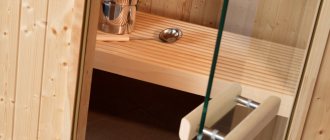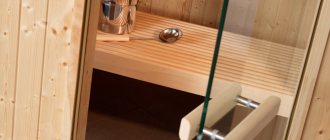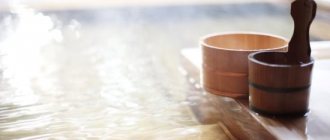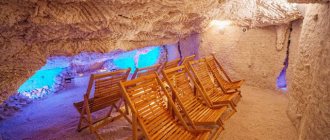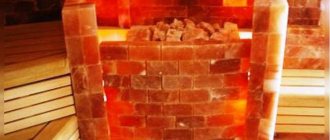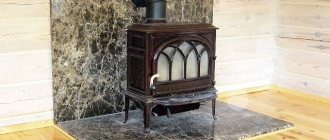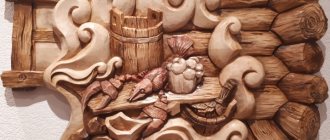Basic principles
In order to make a backlit panel in the steam room, you need to leave a gap of 3-6 cm between the bricks (tiles) and the wall in which the light sources will be located. This gap is necessary, firstly, in order to somehow position the light sources behind the salt, and secondly, so that there is the necessary space for the spread of reflected light. Why exactly reflected? The fact is that if you simply place a powerful light source, it will shine brightly only in one place, that is, it will be point-like. We need to create as uniform illumination as possible. This is achieved only through reflection and re-reflection. The light will be reflected from the foil or film located behind the light sources; be reflected - from the inner surface of the salt itself. How brightly the panel will glow depends on:
- power of light sources;
- the effectiveness of their reflection;
- the thickness of the panel itself.
Everything is clear with the first two points, but what about the thickness? Depending on whether you choose tile or brick, your design will be different.
You can choose a lighting option based on the criterion of replacing light sources: either the element itself is located directly behind the salt, or it is located in another place. Sources that are behind the salt - LED strips (tubes), incandescent lamps; outside the panel there is a projector with an LED that illuminates the panel through an optical fiber. Accordingly, to replace the LED strip, you will need access to its installation site. There are two access options: behind the wall or in front, i.e. dismantling the wall. In the case of fiber optics, the projector must be replaced, which may be located outside the steam room, or under shelves (with a service life of 50,000 hours, this is unlikely to be necessary).
Types of illuminated walls
Installation of brick panels using Himalayan salt adhesive
This installation method, in our opinion, is the most preferable: we get a monolithic structure that will hold securely and will not require further maintenance.
With this installation method, it would, of course, be appropriate to use a fiber optic kit with the projector. If you choose an LED strip or tube, you will need to organize access behind the wall (if possible), or accept the fact that when the strip (tube) burns out, the wall will no longer be illuminated.
You can purchase adhesive composition for salt products from anyone who sells Himalayan salt. It is usually mixed with water in a certain proportion, and does not set immediately. After this composition has completely hardened, your wall becomes monolithic. It is important to note that when using bricks, you most likely will not need to prop up the wall while it dries, since the salt brick will be held up due to its width. To fix it in a horizontal plane in the room being used, it is necessary to use support strips from the inside and layouts from the outside.
The finished version looks like this:
Installation of tile panels using Himalayan salt adhesive
Unlike brick, tiles will most likely not hold up when the mortar dries, so the structure must be supplemented with temporary support. You will also need constant support, because even after the mortar has completely set, a tile wall will not be as stable as a brick wall. As a permanent support, you can use a large metal mesh on which the panel will rest.
It is also necessary to provide for attaching the salt panel to the mesh, because we do not have any support in front. In the photo, the salt tile is tied with a nylon thread threaded through a mesh, i.e. we actually tie our panel to a grid, as a result of which it is fixed in space.
Recommendations for the light source are the same as in the first paragraph.
The result will look like this:
"Dry" installation
In our opinion, the least justified type of installation is associated with a number of inconveniences and further maintenance.
I’ll say right away that due to the complexity of maintenance and the unsuitable quality of the source material, we currently do not use this type of installation.
For dry installation you will need aluminum profile guides. Salt products will be installed on them. The guides themselves are attached to the wall through pieces of rectangular aluminum profile. An LED strip or tube is laid in this space.
I note that “dry” installation should be used only if it is not possible to organize access to the backlight from the other side and an LED strip or tube is used as a light source. When using optical fiber, there will be access to the light source because the projector is not behind the salt wall.
To install bricks (tiles) on the profile, you need to make grooves in the bottom and top of the tile.
Since there is no mortar in this design, there are no seams between the products, so each tile must correspond to the stated dimensions and have right angles. In practice, this is observed for a small proportion of products, resulting in the need to adjust each product, which significantly increases the overall installation time.
There is only one advantage here - the ability to replace light sources after dismantling all the tiles or bricks.
Selecting a light source
Fiber Optic Spot Lighting
The most suitable option, in our opinion.
It does not require replacement of lamps (the service life of the LED in the projector is 50,000 hours).
The fiber can withstand temperatures up to 180 °C.
You can vary the brightness of the lighting by the number of points used per meter.
There is only one drawback - the relatively high cost.
Linear fiber optic lighting
The most expensive option.
Due to the design features, it will not be possible to install it everywhere, because... The fiber length of all rulers is the same, and the rulers themselves are installed at different distances from the projector.
Withstands lower temperatures than dots (80 °C).
LED tubes
We are talking about tubes from manufacturers of sauna equipment.
They have a protective box, which makes it possible to operate them at high temperatures.
After the tube burns out, it needs to be replaced.
The tubes have a set of fixed lengths.
LED strips
Such tapes are produced, among other things, by manufacturers of equipment for the construction of saunas. They have a protective shell, thanks to which they can be used at high temperatures.
After burnout, they require replacement.
Despite the protective sheath, such tapes are still not designed to withstand the same high temperatures as optical fiber.
Incandescent lamp
Yes, yes, an ordinary light bulb. But it is installed, of course, not behind the stove where the panel is mounted, but behind this lampshade made of Himalayan salt:
Himalayan bath salt - how to use it in a steam room for decoration
We will send the material by email
Bathhouse projects
It is no longer enough for today’s owners of private houses to simply build an ordinary bathhouse; they also want to somehow stand out from the general gray mass. You can, of course, build some kind of medieval “tower” or install an original cast-iron lattice in the form of a fence. However, you don’t have to take such radical steps and first practice… decorating. Even a classic building can literally sparkle with new colors if you decorate one of the walls with original material. We are talking about Himalayan bath salt and how to use it in a steam room.
What is Himalayan salt
Himalayan pink salt is the same common table salt that is on any kitchen counter, poured into a salt shaker. Its characteristic color is given by its rich mineral composition.
The fact is that NaCl is extracted in several ways:
- Sea water evaporates, leaving behind only salt. If this process is natural, then it is called self-settling, but it happens that the saline solution is evaporated in special reservoirs, that is, the natural process is repeated.
- Boiling or evaporating salty lake water.
- Mining in deep mines, caves and quarries.
At the same time, the salt contains foreign impurities in small quantities, mainly various microelements. The purer the salt from these inclusions, the more processing it has undergone. Himalayan pink salt is mined by hand in the mines of Pakistan, there is no processing at all, which is why it is so highly valued. Due to the peculiarities of its formation and extraction, such salt is usually called rock salt or halite. It is noteworthy that from the mine to the Himalayas themselves are about 300 km in a straight line.
There are other, “colored” varieties of table salt: black, pink, red, blue and even purple. However, Himalayan pink is the most famous among them due to its mineral composition. Its composition includes iron (it turns salt pink), manganese, magnesium, fluorine and many other components - about 80 items in total.
cooling tower
Just imagine, every person passes 15-25 kg of air through their lungs every day, and this is in a calm state; with physical activity, the figures increase several times. The air in the city is filled with bacteria, viruses, tiny particles of dust, mites; large factories and cars emit carbon dioxide and various chemical impurities. As a result, a large number of city residents are susceptible to diseases associated with decreased immunity: ARVI, allergies, etc.
Salt-saturated air with negatively charged ions greatly facilitates pulmonary ventilation, facilitating the rapid absorption of oxygen. At the same time, they remove significant amounts of carbon dioxide and improve heart function. Salt aerosol improves performance, both mental and physical. It also strengthens bone tissue, accelerates the synthesis of important vitamins C and B. Thus, the cooling tower restores the immune system and respiratory system.
To create the structure, hardwood is used: Canadian or Siberian cedar. The choice of material is largely determined by the characteristics of the cooling tower. Hard and durable wood that has undergone heat treatment is practically unaffected by the salt environment and will last for a very long time. Birch branches are used in the cooling tower. This tree is a unique symbol of the central part of Russia, and its wood is used in many areas of construction. And when laying the cooling tower, birch branches became a good help, since they bend well and are easy to lay in even rows. Among other things, the branches themselves are thin, and over time, intricate salt patterns will be visible on them. WDT equipment supplies brine to the cooling tower branches.
Thus, all types of salt baths are aimed at improving health and improving immunity. Breathe deeply.
Application
Pink salt can be used in exactly the same way as regular salt - as an additive to food or as a decoration. There is various information about its beneficial qualities, but they are not proven from a scientific point of view. In addition, increased salt consumption for the purpose of health improvement can have the opposite effect and lead to the development of diseases of the cardiovascular system, stomach and even cancer. In addition, salt retains fluid in the body, which can cause swelling.
The maximum healing effect that can be obtained from visiting a bath with Himalayan pink salt is akin to that achieved from being in the so-called salt caves.
Be that as it may, it should be remembered that the daily need of the human body for sodium chloride in any form is no more than 5 grams (slightly less than one teaspoon).
Pink Himalayan salt is used in cosmetology and cooking. The fact is that slabs made from such salt can withstand significant temperatures - up to 200 0C - thanks to which they can be heated and then used as a regular stove.
People most often try to use bath salt in briquettes when decorating rooms, in particular, saunas and steam rooms.
Features of care
It is noteworthy that different combinations and powers of sodium chloride sources (slabs or salt spraying) provide equally different dosages of negatively charged air ions. According to this theory, there are different durations of stay in a room with a salt wall:
- If the concentration of negative chlorine ions is 5 thousand/1 cm3, then the effect is identical to a walk in a pine forest or near the seashore during a small storm.
- If the concentration is 8 thousand/1 cm3, the effect is identical to a walk in the mountains.
- At 30-35 thousand/1 cm3 the effect is equal to the therapeutic effect, which is controlled by a doctor. But, with a strong desire, it is impossible to recreate such a climate at home.
In order for a room with a salt wall not only to please the eye, but also to serve for a long period of time, it is recommended to monitor the humidity in the room, not drink hot drinks or alcohol in the room, and also limit the number of visitors to 3 people per room of approximately 30 square meters. meters.
A visit to the salt room stabilizes blood pressure, helps relieve stress, increase stress resistance, overcome insomnia and spring fatigue syndrome, and strengthen the immune system. But, in order for the salt wall to serve for a long time, it is necessary to follow the rules of work at all stages, as well as monitor the humidity in the room. For connoisseurs of natural space design, such a salt wall will be a universal way to express themselves.
How to use Himalayan salt in a bath
There are several different ways to use Himalayan bath salt as decoration, taking advantage of the unusual appearance of this mineral:
- Buy a salt lamp . This is, in fact, a rather original lamp, which is a piece of salt with a light bulb placed inside. If you plug such a lamp into the network, it will shine with a pleasant reddish-yellow light. An excellent solution for baths and saunas, and you can choose a lamp based on the size of the room: the larger the area, the more massive the piece of mineral will be.
- Buy a small amount of salt by weight and put it in a beautiful decorative bowl, then hang it in the bathhouse. In this form, it will be a wonderful addition to the interior.
- Lay out a partition wall from salt blocks between the bathhouse itself and the dressing room. They are fastened together with special glue or attached to a metal frame.
- You can not limit yourself to just one partition, but cover one or more walls and floor with slabs, lay out intricate paths on it, and decorate the ceiling with salt tiles.
- The most expensive option is to lay the entire wall out of pink bricks and backlight it with lamps. Thus, it is possible to achieve a unique atmosphere, creating an atmosphere of relaxation and tranquility. It turns out that going to the bathhouse cleanses not only the body, but also the thoughts and soul, anxiety is reduced, and depression is alleviated.
Floor installation
The next thing to do is arrange the floor. For this purpose, it is necessary to select salt lumps no more than 15 centimeters wide. If during procurement it is not possible to load a multi-fraction composition, then preference should be given to larger components. Subsequently, large pieces can be separated using a turbine and chisel. To cut salt, you must use concrete discs.
The process of laying salt blocks on the floor is similar to installing paving slabs. A layer of moistened salt is laid on the floor. It should form into a lump when compressed, but not release water. Salt blanks are sequentially laid out on the litter and compacted using a rubber hammer. For this purpose, it is better to purchase the latter with white rubber, since it does not leave marks. The resulting cavities are also filled with a salt composition.
Precautionary measures
Before we begin to describe in more detail how to use Himalayan pink salt in a bath, we should say a few words about in what cases it is best to use it.
Salt's worst enemy is water. Exposure to moisture gradually destroys it; in other words, water will sooner or later completely dissolve all the salt. Since this usually happens from the bottom up, it is possible that the wall will collapse on the heads of the guests.
Therefore, the main rule on how to properly use salt in a bath as a decoration is no moisture. It is best if it is a dry Finnish sauna; a traditional Russian bathhouse is not suitable for these purposes. It is in the sauna that you can achieve the lowest humidity value for this type of room - 55%.
The next point is sufficient ventilation. In order for the moisture to evaporate as quickly as possible, without having time to react with the salt blocks, it is necessary to ventilate the premises well after guests have used the sauna.
Premises requirements
A salt room will require an enclosed space. Ideally this should be a custom build, but any single room will do. It must meet the following conditions, which tell you how to make a salt room:
- As they say in the reviews, it is best to use the basement. Also, priority is given to semi-basement apartments, and only in exceptional cases choose a room on the ground floor.
- The room must be dry. It should not contain water or sewer pipes or electrical wiring.
- The floor must have a concrete base. The wooden flooring will have to be removed, and if necessary, the screed will have to be cast.
- The minimum height of such a room should be 2.4 meters, and ideally 3 meters.
If a premises that meets the specified requirements is already available, then you can begin purchasing material and organizing preparatory work. If a suitable separate room is not found, you will have to make an individual building.
Lamp
As a rule, lamps made from pieces of salt are factory-made, and bathhouse owners most often go to the store to buy a ready-made product, although you can make it yourself.
The easiest way to use Himalayan salt in a bathhouse is to secure a wooden basket in a pre-selected place in the bathhouse, into which salt is poured in the form of small pieces or coarsely ground pebbles. An ordinary light bulb (preferably LED) of a warm color is attached to the inside of the basket for illumination. This option is the most budget-friendly option for a lamp made from Himalayan pink salt.
A somewhat more complex and expensive, but also more advantageous way to use salt tiles for a bath is to create a full-fledged portable lamp from Himalayan salt tiles. To do this, the tiles are laid in a special way - in the form of a box without a bottom. Individual tiles can be secured to each other either using special glue or with clamps made of metal or any other durable material.
The assembled lamp must be mounted on a base made of wood or plastic, made in the form of a regular plate (for example, a sheet of plywood). The socket with the lamp is also brought from below and fixed to the base so that the lamp itself does not touch the walls of the lamp.
Waterproofing
How to build a salt room? When waterproofing walls, special building mixtures that have these characteristics are used. In stores that specialize in selling this group of products, consultants can easily help you find the appropriate composition. In modern construction, such products are in demand, so finding the right mixture is not difficult.
To apply the insulating composition to the wall, it must be diluted with water to form a thick paint. Then, using a wide brush, apply successively to the wall. It is better to start from the top, gradually lowering to the floor. Thus, the thickness of the insulating layer applied in this way should be about two millimeters.
Wall of salt
It’s worth saying right away that there are absolutely no restrictions on how much area to cover with halite tiles or blocks - the question depends entirely on the bathhouse owner’s wallet and his creative ambitions. This can be either a small partition or an entire room lined with salt bricks from top to bottom.
Preparation
The most important rule for starting the installation of a Himalayan salt wall is that the surfaces are completely dry. Therefore, everything is first cleaned of dust, dirt, remnants of building materials and finally wiped with a dry cloth.
The surface of the salt bricks themselves is also cleaned of any dirt and dust with a brush and degreased before applying a layer of glue.
The surfaces to which they are to be attached are cleaned with sandpaper. If it is wood, then choose coarse-grained sandpaper, and if it is glass, then choose fine-grained sandpaper.
To make the most of the decorative component of salt for baths and saunas, you should choose bricks or tiles of different shades. A wall made of such different parts will look most advantageous.
DIY salt wall in an apartment: application options
Options for applying salt to walls depend on the following features:
- The area intended for the application of crystals.
- Room temperature.
- Possibility to install the necessary equipment.
- Wall bases - concrete or brick wall - are the best option.
There are several options for forming a salt wall in a room:
- Soaking the burlap.
- Spray
- Planting blocks with glue.
- Decoration with large crystals.
Video description
For little tricks you need to know when using a wall made of Pakistani salt, watch the following video:
Building a wall
A load-bearing structure made of vertical metal profiles is first mounted on the walls, and horizontal gutters are already installed on them. The tile itself is inserted into these grooves like a panel.
Sauna owners most often choose this method of fixing salt stones for a bath; using fastening glue is considered not a completely reliable method.
However, a special glue based on salt itself and caustic magnesite is used to glue the blocks. They are mixed with water in a ratio of 5:3 or 3:2. The resulting glue is used immediately, within 10 minutes, as it dries very quickly.
For those who do not want to prepare glue themselves, two-component dry adhesive mixtures are sold, which are diluted in water and are used up just as quickly.
After the wall is completely assembled and its individual blocks are glued together, you should exclude the slightest drafts in the bathhouse for a day until the wall is completely dry, although the glue itself dries in 4 hours.
As an alternative to such a traditional adhesive composition, liquid glass can be used for salt and briquette baths. However, when using such a cheap substitute, the assembled wall will not be very strong.
Backlight
It’s good when daylight penetrates through the partition, because in this case additional lighting will not be needed.
It's another matter when the wall is covered. In this case, it is extremely important to highlight the entire wall. Light penetrating through the salt bricks will diffuse a soft and warm orange light throughout the room.
Here are just a few of the requirements for electric lighting on a wall made of Himalayan pink salt:
- The wiring must withstand high temperatures, because it is possible that it will pass next to the hottest wall, where the temperature can reach hundreds of degrees;
- Another important factor is moisture, which has an extremely negative effect on electrical circuits and devices. Therefore, it is best to take care of purchasing moisture-resistant components in advance.
- Availability. No matter how good the wiring itself is, it may require inspection, albeit visual, or even repair. Therefore, it is better to lay it in such a way that in the future you do not have to disassemble the entire salt wall to inspect the cable insulation.
- LED strips are best suited for lighting. They consume little current and are less demanding on the environment.
Other uses
Halite blocks can withstand temperatures up to 500 0C, so salt stones for a bath can be used as a protective screen around a hot stove. The blocks accumulate heat from the stove well and thus warm up all the air inside the steam room.
Another side and truly exotic use of Himalayan pink salt is the construction of a working fireplace from it.
Instead of erecting an entire wall, some owners limit themselves to creating small panels of Himalayan halite on the walls, always illuminated from the inside.
Salt stone for a bath can be used like ordinary stove stones, for which small samples of it (cereals, pebbles, small stones) are stacked on the stove itself. After this procedure, the halite is taken out into fresh air and dried in the sun until next time.
Briefly about the main thing
Pink Himalayan salt is ordinary table salt that is mined by hand in one of the Pakistani mines. It is used as a seasoning for food, in cosmetology, and as a cooking surface for cooking. Bath salt can be used in a steam room, both when decorating saunas and steam rooms, and to create a “salt” atmosphere inside the sauna. The health-improving effect of using this finishing material is questionable and remains on the conscience of the bathhouse owner himself, but its harmlessness has been absolutely proven.
The walls are tiled with tiles or salt blocks, and backlit with lamps or LEDs. First, a load-bearing profile is constructed, and the blocks are inserted into it like a typesetting panel. You can also limit yourself to simple masonry using homemade or factory-made glue based, in fact, on salt and magnesite itself.
You can also make lamps, panels, sun loungers from Himalayan halite, lay out paths in a bathhouse, and use them as stove stones.
Source
Useful properties of the mineral
Himalayan salt is a complex healing mineral. It is recommended not only by practitioners of alternative medicine, but also by doctors with good education and extensive experience. Salt has the following beneficial properties:
Medical recommendations for the use of salt from the Himalayas boil down to the enormous benefits of its evaporation. The mineral evaporates when heated - both during cooking and during bath procedures. Salt vapors can treat a number of diseases:
You can also rinse your mouth with a salt solution to achieve fresh breath. And compresses or baths with saline solution relieve swelling on the legs and remove blue bags under the eyes.
